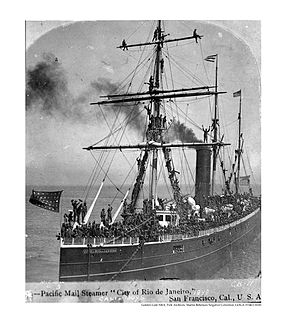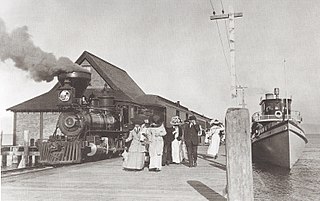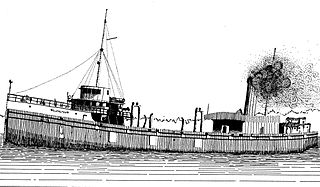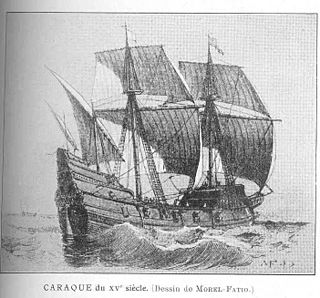
The San Francisco Maritime National Historical Park is located in San Francisco, California, United States. The park includes a fleet of historic vessels, a visitor center, a maritime museum, and a library/research facility. The park used to be referred to as the San Francisco Maritime Museum, however the former 1951 name changed in 1978 when the collections were acquired by the National Park Service. Today's San Francisco Maritime National Historical Park was authorized in 1988; the maritime museum is among the park's many cultural resources. The park also incorporates the Aquatic Park Historic District, bounded by Van Ness Avenue, Polk Street, and Hyde Street.

Queen Anne's Revenge was an early-18th-century ship, most famously used as a flagship by Edward Teach, better known by his nickname Blackbeard. Although the date and place of the ship's construction are uncertain, it was originally believed she was built for merchant service in Bristol, England in 1710 and named Concord, later captured by French privateers and renamed La Concorde. After several years' service by French sailors, she was captured by Blackbeard in 1717. Blackbeard used the ship for less than a year, but captured numerous prizes using her as his flagship.
San Pedro Underwater Archaeological Preserve State Park is a Florida State Park located in 18 feet (5.5 m) of water, approximately 1.25 nautical miles (2.32 km) south of Indian Key. It became the second Florida Underwater Archaeological Preserve when it opened to the public in 1989. The heart of the park is the San Pedro, a submerged shipwreck from a 1733 Spanish flotilla, around which visitors can dive and snorkel. The San Pedro, a 287-ton Dutch-built vessel, and 21 other Spanish ships under the command of Rodrigo de Torres left Havana, Cuba, on Friday, July 13, 1733, bound for Spain. The San Pedro carried a cargo of 16,000 silver Mexican pesos and crates of Chinese porcelain. A hurricane struck the fleet, while entering the Straits of Florida, and sank or swamped most of the fleet. The wrecksite includes an "eighteenth century anchor, replica cannons, ballast stones encrusted with coral, a dedication plaque, and a mooring buoy system." The wreck was added to the U.S. National Register of Historic Places on May 31, 2001.

SS Winfield Scott was a sidewheel steamer that transported passengers and cargo between San Francisco, California and Panama in the early 1850s, during the California Gold Rush. After entering a heavy fog off the coast of Southern California on the evening of December 1, 1853, the ship crashed into Middle Anacapa Island. All 450 passengers and crew survived, but the ship was lost.

The SS City of Rio de Janeiro was an iron-hulled steam-powered passenger ship, launched in 1878, which sailed between San Francisco and various Asian Pacific ports. On 22 February 1901, the vessel sank after striking a submerged reef at the entry to San Francisco Bay while inward bound from Hong Kong. Of the approximately 220 passengers and crew on board, fewer than 85 people survived the sinking, while 135 others were killed in the catastrophe. The wreck lies in 287 feet (87 m) of water just off the Golden Gate and is listed in the National Register of Historic Places as nationally significant.

SS Tahoe was a steamship that operated on Lake Tahoe at the end of the 19th century and the first half of the 20th. Scuttled in 1940, the wreck presently lies in 400 feet (120 m) of water off Glenbrook, Nevada. The wreck was first visited in 2002 by a team from New Millennium Dive Expeditions (NMDE) in a record-setting high-altitude dive for Lake Tahoe. As a result of the work that NMDE did on the Tahoe site from 1999 up to their dives in 2002, Tahoe became the first maritime site in Nevada to be listed in the National Register of Historic Places.
James Preston Delgado is a maritime archaeologist, historian, maritime preservation expert, author, television host, and explorer.

USS Puritan, a civilian transport built by Craig Shipbuilding Company in Toledo, Ohio, was launched in 1901, and lengthened by 26 ft (7.9 m) in 1908. The ship sailed on the Great Lakes in passenger service, was purchased by the U.S. Navy at the end of the war, and returned to passenger service after the war. The ship sank in 1933 near Isle Royale in Lake Superior, and its wreck is listed on the National Register of Historic Places.

PS Portland was a large side-wheel paddle steamer, an ocean-going steamship with side-mounted paddlewheels. She was built in 1889 for passenger service between Boston, Massachusetts, and Portland, Maine. She is best known as the namesake of the infamous Portland Gale of 1898, a massive blizzard that struck coastal New England, claiming the lives of over 400 people and more than 150 vessels.

King Philip was a 19th-century clipper ship launched in 1856 and wrecked in 1878. The wreck of this ship is only rarely visible; very infrequently the timbers can be seen protruding from the sands of Ocean Beach, on the Pacific Ocean coast of San Francisco, California. The wreck is the "most complete remains of an American medium clipper." This is a shipwreck of one of many ships that were wrecked in and around San Francisco Bay.

The Glenlyon was a freighter built in 1893; it was sunk off the shore of Isle Royale in Lake Superior in 1924 and the remains are still on the lake bottom. The wreck was placed on the National Register of Historic Places in 1984.

The Cumberland was a wooden-hulled side paddlewheeler built in 1871; it was wrecked off the shore of Isle Royale in Lake Superior in 1877 and the remains are still on the lake bottom. The wreck was placed on the National Register of Historic Places in 1984.

The Henry Chisholm was a wooden freighter; it was sunk off the shore of Isle Royale in Lake Superior in 1898 and the remains are still on the lake bottom. The wreck was placed on the National Register of Historic Places in 1984.

SS Monarch was a passenger-package freighter built in 1890 that operated on the Great Lakes. She was sunk off the shore of Isle Royale in Lake Superior in 1906 and the remains of her wreck and cargo are still on the lake bottom. The wreck was placed on the National Register of Historic Places in 1984.
Many ships have wrecked in and around San Francisco Bay. For centuries San Francisco Bay, with its strong currents, rocky reefs, and low fog conditions has experienced more than a hundred shipwrecks. Ever since San Francisco Bay was discovered during the land expedition of Gaspar de Portolà in 1769, it has been one of the most popular harbors.

SS Aleutian was a passenger ship in North American coastal service. Built in 1899 for the Ward Line as SS Havana, she would later serve the building of the Panama Canal as SS Panama and ultimately enter Alaskan service as SS Aleutian.

San Esteban was a Spanish cargo ship that was wrecked in a storm in the Gulf of Mexico on what is now the Padre Island National Seashore in southern Texas on 29 April 1554.
The Kad'yak, also known as Kadyak and Kadiak, was a wooden-hulled sailing merchant ship belonging to the Russian-American Company. Purchased by the company in 1851, she was used to transport personnel and supplies among its settlements in Russian Alaska, and to transport trade goods to San Francisco. On April 2, 1860, she struck a rock near the port of Kodiak, Alaska while carrying a load of ice and trade goods destined for San Francisco, and sank near Spruce Island after drifting for three days.

The Sport was a tugboat, built in 1873 and wrecked in 1920 in Lake Huron. The wreck site, designated 20UH105, was listed on the National Register of Historic Places in 1992.

The Australasia was a wooden hulled American Great Lakes freighter that served on the Great Lakes of North America between her construction in 1884 to her burning and sinking in 1896. On October 18, 1896 while loaded with coal, the Australasia sank in Lake Michigan near the town of Sevastopol, Door County, Wisconsin, United States, after burning off Cana Island. On July 3, 2013 the wreck of the Australasia was added to the National Register of Historic Places.




















